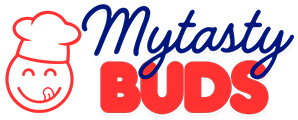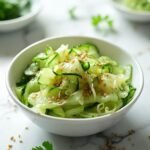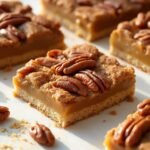Cheesecake is a top dessert favorite for many, with its creamy texture and sweet flavor. The question is, are eggs part of the cheesecake ingredients? This is key for people who can’t or prefer not to eat egg-free cheesecake. Knowing why eggs are used in cheesecake is important.
- Key Takeaways
- Understanding the Role of Eggs in Cheesecake
- Classic Cheesecake Ingredients
- Step-by-Step Guide to the Perfect Cheesecake
- Texture Variations: Exploring Egg Quantities in Cheesecake
- Alternative Ingredients for Different Cheesecake Textures
- The Science of Cheesecake: Why Eggs Matter
- Common Cheesecake Mistakes to Avoid
- Eggless Cheesecake Options: Substitutions That Work
- Conclusion
- FAQ
- Does every classic cheesecake recipe include eggs?
- Can I make an egg-free cheesecake that still has a great texture?
- What’s the role of eggs in the cheesecake’s structure?
- What are the key ingredients for creating a classic cheesecake’s sweet filling?
- How do you create a sturdy crust for cheesecake?
- Are there specific techniques for mixing cheesecake filling?
- Why use a water bath when baking cheesecake?
- How does varying the egg quantity affect cheesecake texture?
Eggs play a big role in baking. They bind ingredients, add structure, and make things smooth — all of which are needed for perfect cheesecake. They work with cream cheese, sugar, and vanilla to create that velvety feel. While lemon adds a nice zest, eggs are key for that top-notch cheesecake taste.
Now, there are new ways to make egg-free cheesecake that still taste great. Let’s explore how cheesecake relies on eggs and how it can do without.

Key Takeaways
- Traditional cheesecake recipes typically highlight eggs as a key ingredient for structure and texture.
- Eggs are crucial in cheesecakes for binding ingredients and imparting a creamy consistency.
- Egg-free cheesecake alternatives are available for those with dietary restrictions or preferences.
- Understanding the role of eggs can help in perfecting the texture and flavor of homemade cheesecake.
- Citrus notes can enhance the flavor profile of a classic cheesecake recipe, complementing the richness of the other ingredients.
- Exploring the function of eggs in cheesecake can improve both traditional and innovative baking techniques.
Understanding the Role of Eggs in Cheesecake
Eggs are essential for making cheesecake perfect. They give cheesecake its structure and creamy texture we all love. By mixing with other ingredients, eggs help form a rich cheesecake custard.
They bring stability and keep the cheesecake’s shape after cooling. This makes eggs more than just a simple ingredient.
While baking, egg proteins harden and make the cheesecake solid. Yet, it stays smooth and creamy. This change is crucial for the cheesecake to feel soft but also allows clean slicing.
In short, eggs turn the liquid cream into a yummy solid custard. They’re the magic touch in cheesecake.
| Ingredient | Role in Cheesecake | Impact on Texture |
|---|---|---|
| Eggs | Bind ingredients, aid setting | Increases creaminess, supports structure |
| Cream Cheese | Main flavor and body | Rich, dense texture |
| Sugar | Sweetness, helps in browning | Balances texture, adds smoothness |
Getting the egg to cream cheese ratio right is critical. This balance makes the cheesecake creamy but firm and not too dense.
Understanding this helps bakers nail the ideal cheesecake structure and creamy cheesecake texture every bake.
Classic Cheesecake Ingredients
Making the perfect cheesecake, means every ingredient must be just right. The cream cheese base and the sweet cheesecake filling are key. They work together to create a creamy texture and rich flavor we all love.
The Essential Base: Cream Cheese and Sugar
The journey to an amazing cheesecake begins with quality cream cheese and sugar. This duo ensures the cheesecake’s creamy texture. It also allows other cheesecake flavor enhancers to stand out.
Adding Flavor Depth: Vanilla and Citrus Notes
High-grade vanilla extract and fresh citrus zest add exciting flavors. Vanilla brings a warm, floral scent that goes well with the tangy cream cheese. Citrus, like lemon or orange zest, adds a fresh, bright taste, lifting the cheesecake’s flavor.
Binding Elements Together: The Significance of Eggs
Eggs play a vital role in cheesecake by bringing everything together. They mix the cream cheese, sugar, and other flavors into one smooth mixture. Eggs make sure the cheesecake is dense, creamy, and holds its shape, giving us that perfect texture.
| Ingredient | Role in Cheesecake | Taste Impact |
|---|---|---|
| Cream Cheese | Base | Creamy, rich texture |
| Sugar | Sweetener | Enhances sweetness |
| Vanilla Extract | Flavor Enhancer | Adds depth and aroma |
| Citrus Zest | Flavor Enhancer | Introduces a bright, tangy note |
| Eggs | Binder | Improves texture and cohesiveness |
Step-by-Step Guide to the Perfect Cheesecake
Starting to bake a cheesecake means learning key steps for the best dessert. This guide focuses on making a smooth filling and why using a water bath is good.
Creating a Sturdy Crust
First, you’ll make a strong base for the creamy filling. Mix ground graham crackers with melted butter and sugar for the crust. Press this mix firmly into your pan’s bottom and sides to support the soft filling on top.
Mixing the Perfect Filling: Techniques and Tips
To get a smooth filling, mix quality ingredients that are room temperature. Room-temperature cream cheese, eggs, and other items help avoid lumps. Add eggs one by one, mixing softly to prevent air. This keeps the cheesecake from cracking when it’s baked.
Cooking Method: Water Bath for Smoothness
Using a water bath cook the cheesecake gently. This method heats it evenly and stops cracks. Wrap your springform pan in foil to keep water out. Then, place it in a baking pan filled with hot water about halfway up the cheesecake pan.
This approach helps maintain your cheesecake’s ideal texture. It makes it super smooth, creamy, and as nice to look at as it is to eat.
The key to the best cheesecake isn’t just following a recipe. It’s about knowing why each step matters. With this guide, you’ll impress everyone with your baking skills.
Texture Variations: Exploring Egg Quantities in Cheesecake
Changing the egg quantity in cheesecake greatly affects its texture and feel. We’ll look at how egg amounts can change the cheesecake’s density and creaminess.
Reducing Eggs for a Denser Cheesecake
Want a cheesecake density that’s rich and firm? Use fewer eggs. This makes the cheesecake compact and thick. It’s great for those who love a hearty dessert.
Increase Eggs for a Creamier Texture
Want a creamy cheesecake instead? More eggs create a delicate, smooth feel. It’s like a mousse and perfect for fans of soft, luscious desserts.
| Egg Quantity | Texture Result | Suitable For |
|---|---|---|
| 1-2 Eggs | Denser and Firmer | Ricotta or New York Style |
| 3-4 Eggs | Moderately Creamy | Classic or Traditional Cheesecake |
| 5 or More Eggs | Very Creamy and Light | French or Soufflé Cheesecake |
Egg quantity in cheesecake does more than change texture. It also matches the cake to cheesecake styles. Whether it’s denser or creamier, egg count helps you make the perfect dessert.
Alternative Ingredients for Different Cheesecake Textures
Making a creamy eggless cheesecake or using dairy substitutes means trying different cheesecake thickening agents. These ingredients help keep the classic cheesecake feel. This is great for those with food limits or who love trying out new textures.
If you’re looking for egg-free choices, there are plenty of options. These help you get that creamy feel without losing taste.
- Condensed Milk: It brings richness and acts as a great thickener.
- Heavy Cream: Adds a smooth feel similar to regular cheesecakes.
- Greek Yogurt: Puts in a tangy kick and helps with the filling’s creaminess.
For those avoiding dairy, there are good substitutes. These let people with lactose intolerance or who are vegan still enjoy cheesecake.
- Sour Cream: Plant versions give that creamy feel with a bit of tang.
- Cashew Milk: It has a creamy texture and mild flavor, perfect for vegan cheesecakes.
- Buttermilk: For a lighter feel, mix plant milk with an acid like lemon juice or vinegar.
Using these substitutes opens up cheesecake to everyone. It also lets food lovers try different aspects of this favorite dessert.
The Science of Cheesecake: Why Eggs Matter
In the world of cheesecake science, each ingredient plays a big role. Eggs are especially important for making the rich, smooth cheesecake custard texture we love. They do more than just bind ingredients. They make the mix creamy through a process called emulsification.
Eggs as Emulsifiers
Eggs make a big difference in cheesecakes. They mix oil and water parts that usually don’t blend. This makes the cheesecake smooth and delicious. The lecithin in egg yolks helps a lot in making the cheesecake hold together.
Custard Formation and Egg Ratios
Turning batter into a baked cheesecake shows how important eggs are. As eggs warm up, they solidify the mix into a firm custard. Getting the egg amount right is key. Too many eggs can make it rubbery, and too few might not set it right. Bakers adjust egg amounts to change the texture, from light to rich.

| Egg Quantity | Texture Result | Common Uses |
|---|---|---|
| 1-2 eggs | Denser, firmer cheesecake | New York Style |
| 3-4 eggs | Creamier, smoother cheesecake | French Style |
| 5 or more eggs | Very soft, custard-like texture | Japanese Style |
Common Cheesecake Mistakes to Avoid
Mastering the perfect cheesecake comes down to sidestepping mistakes that affect the texture and look. Let’s explore key cheesecake cooking tips. Learn strategies for avoiding cheesecake cracks for a smooth cheesecake every time.
- Crust Issues: A crust not pressed enough can cause problems. Make sure your base is firmly packed and spread out evenly.
- Ingredient Temperature: Cold ingredients lead to clumpy batter. For a smooth mix, use ingredients at room temperature.
- Mixing Technique: Too much mixing adds air, causing cracks. Mix just until things are blended.
- Egg Proportion: Too many eggs make the batter expand too much, resulting in cracks. Be careful with the number of eggs.
- Baking Temperature: A very hot oven cooks the outside too quickly. An oven thermometer helps keep the temperature right.
Now, let’s look at this table highlighting common mistakes and fixes:
| Mistake | Impact | Solution |
|---|---|---|
| Under-pressed crust | Weak structural base | Firmly press down the crust in an even layer. |
| Cold ingredients | Lumpy batter | Allow ingredients to reach room temperature before mixing. |
| Over-mixing the batter | Incorporates too much air, leading to cracks | Mix until just combined, avoiding high speed. |
| Excessive eggs | Overexpansion and surface cracking | Use the correct number of eggs as specified in the recipe. |
| Incorrect baking temperature | Overbaked texture, potential burning | Monitor oven temperature and adjust as necessary. |
Avoid these common mistakes and follow this smooth cheesecake advice. Your dessert will be rich, creamy, and impressively smooth for your next event!
Eggless Cheesecake Options: Substitutions That Work
Looking to enjoy cheesecake without eggs? There are many great substitutes. These options cater to those who prefer dairy-free and eggless treats. Now, everyone can savor a slice of this classic dessert.
Condensed Milk as an Alternative Thickener
Eggless cheesecake can be creamy and thick with condensed milk. This ingredient adds to the dessert’s body and sweet flavor. It cuts down the need for extra sugar too.
Plant-Based Milk Varieties for Dairy-Free Preferences
Plant-based milks like almond, soy, or cashew milk work well for dairy-free cheesecake. They bring a rich, creamy texture and enhance the flavor. Adding them to your dairy-free cheesecake mix adds unique tastes.

| Ingredient | Role in Cheesecake | Benefits |
|---|---|---|
| Condensed Milk | Thickener and Sweetener | Gives the desired consistency akin to traditional cheesecake, perfect for various dietary needs |
| Cashew Milk | Base for Dairy-Free Cheesecake | Offers a creamy texture and enriches flavor, ideal for lactose-intolerant individuals |
| Cornstarch | Alternative Thickener | Gives desired consistency akin to traditional cheesecake, perfect for various dietary needs |
Conclusion
Throughout our journey to making the perfect cheesecake, we’ve seen the egg’s true colors. Far from simple, eggs are key in baking. They give cheesecake its creamy texture and richness. By changing the egg amount, we can tweak the dessert’s texture. This makes the cheesecake adaptable to many tastes and needs.
Looking for a fluffier cheesecake or maybe something denser? Cheesecakes can be just that. This dessert’s flexibility is its superpower. For those new to baking, understanding eggs’ role is critical. It helps avoid common mistakes. Knowing how to prep ingredients and using a water bath makes your cheesecake stand out.
Now, it’s your turn to take this classic dessert and make it your own. Armed with our tips and your creativity, even basic ingredients can become extraordinary. Celebrate the endless possibilities of cheesecake making. It’s a way to express personal taste and share a love for delightful desserts with others.









